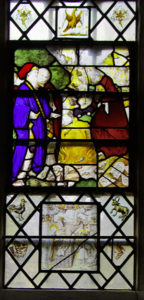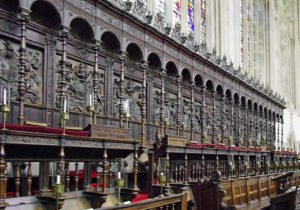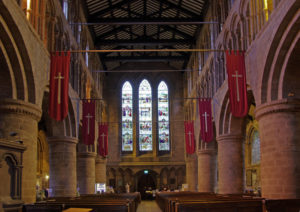Mention Cambridge and most people will immediately think of the iconic King’s College Chapel. The Festival of Nine Lessons and Carols is still a popular start to the Christmas festivities.
King’s College Chapel has everything going for it with its fan vaulting, medieval stained glass and even a Ruben’s painting. No-where else in England can claim such riches. You run out of superlatives to describe King’s College Chapel. It is one of the best examples of late Medieval architecture in the country.
Although it now charges visitors £9 to enter, this doesn’t deter the number of visitors and it is well worth the money. Even in early March it was busy with a lot of guided tours.
Standing surrounded by grass and college buildings and overlooking the River Cam, this must be one of the most recognised views in Cambridge.
The chapel is big, and I mean seriously big. It dwarfs the surrounding college buildings and is almost impossible to photograph. It is a tall, narrow building with heavily buttressed walls topped with crocketted pinnacles. The side chapels appear insignificant from the outside. The doorways are richly carved with the Royal Coat of Arms and the Tudor rose, a taster of the glories inside.
Henry VI may be regarded by history as a ‘poor’ king in history, but his real legacy is King’s College. This was founded in 1441 to take graduates from Eton College and he was determined the chapel would be ‘without equal in size or beauty’. He certainly succeeded. Land was compulsorily bought and existing buildings demolished. He wanted a grand design based on the lines of a cathedral choir. Work began at the east end.
Richard Duke of York challenged Henry’s right to the throne leading to the Wars of the Roses. When Henry was taken prisoner, work stopped and the masons packed up and went home. Building restarted under Richard III who completed the first five bays of the chapel. Henry VII continued the work, regarding the completion of the chapel as a symbol of his power and status. The ‘join’ can be seen by the different coloured stone on the external north wall of the east end of the chapel. Building styles had changed and there is a marked contrast between the small chapels off the sanctuary with their simple vaulted roofs and the rest of the building with its glorious fan vaulted ceiling. Henry VIII eventually completed the work funding the interior woodwork, the massive stained glass windows and the screen with the organ above. This still bears the initials of Henry and his queen, Anne Boleyn.
During the Civil War, the chapel was used as a training ground for Oliver Cromwell’s troops but survived undamaged, possibly because Cromwell had been a student at Cambridge. The chapel also escaped damage during the Second World War.
Unfortunately, it was quite dark inside the chapel when I visited, explaining the grainy quality of many of the pictures. Unfortunately when I visited, the oak screen between the ante-chapel and the Choir was covered in polythene as the organ is being restored.
The first impression is size. This is the largest fan vaulted ceiling in the world and is simply stunning. The C16th stained glass windows soar to the roof and on a sunny day flood the chapel with different colours of light. Every bit of stonework in the antechapel is embellished with Tudor symbols. There are the Royal Coat of Arms of Henry VII and the Tudor rose. The portcullis was the badge of the Beaufort family and the Greyhound is the emblem of Lady Margaret Beaufort, mother of Henry VII. There is no doubt as to who is responsible for the building of the chapel. The side chapels beneath the windows almost appear insignificant. Unfortunately when I visited, the oak screen between the ante-chapel and the Choir was covered in polythene as the organ is being restored.
It is difficult to decide which is the most impressive thing about King’s College Chapel, the fan vaulted ceiling or the Medieval glass. All the glass, apart from the great west window which is late C19th and made by Clayton and Bell, is C16th Flemish glass. It has images from both the Old and New testaments. The colours are still vibrant even after 500 years.
The inside walls of many of the side chapels are glazed and have beautiful small roundels of medieval glass. The lovely shades of yellow and brown in these roundels was achieved by staining the back of the glass with a silver compound before firing in the kiln.
There is an exhibition in the north chapels explaining how the glass was made. A scale drawing is made first before preparing a full size cartoon on either print or vellum. Colours indicate the shades of glass to be used. Pieces of glass are chipped to the approximate size and placed on the cartoon. The glass is then painted and fired. When cool they are fitted into their correct place on a flat surface and then leaded up
Both sides of the ante-chapel are lined with small chapels. These have fan vaulted ceilings and glassed glass. The Tomb Chapel is on the south wall and is dominated by the massive tomb of the Marquis of Blandford and has an unidentified brass memorial on the floor.
On the north wall are the Whichcote and Founder’s chapels. The Whichcote Chapel by the north door has a painting of the Madonna and child above the altar. This has a small font and is the baptistry for members of the college.
Next to it is the Founder’s Chapel which was reopened in 2010 after years of neglect and disuse. Above the altar is an early C16th Dutch triptych depicting the Adoration of the Magi and the Flight into Egypt. Opposite is a remarkably modern looking painting of the Deposition of Christ which is Italian late C15th.
The choir is separated from the ante-chapel by a massive carved oak screen. This was the first part of King’s College Chapel to be built and is architecturally much simpler than the ante-chapel. The stonework lacks the carving and Tudor symbolism.
The dark choir stalls are still lit by candles.
The great east window depicts the passion and crucifixion. Below it is the Ruben’s painting of the ‘Adoration of the Magi’, which was given to the college in 1961.
The side chapels off the choir are the oldest parts of King’s College Chapel and are very simple with plain stone vaulted ceilings. The St Edward’s Chapel at the end of the north wall is kept for private prayer.
Opposite is the Chapel of All Souls which was converted into the memorial chapel for members of the college and choir who lost their lives in both World Wars. A list of names is carved on the wall and includes that of Rupert Brooke.
This is a wonderful building and the best bit for me was definitely the Medieval stained glass. It was worth the £9 entry charge just to see that. The charge also allows visitors to wander round the grounds of King’s College too.
The post code is CB2 1ST and the grid reference is TL 447584.
There are more pictures “here.”:http://wasleys.org.uk/eleanor/churches/england/cambridgeshire/index.html










